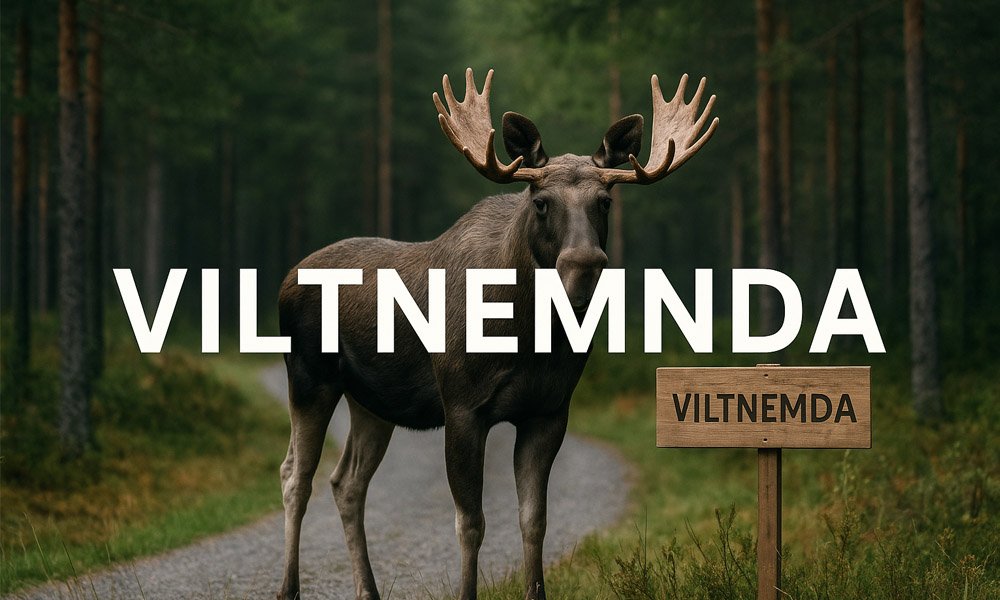Guide
Viltnemnda: Everything You Didn’t Know About Norway’s Wildlife Committees
Published
4 months agoon
By
Archie
Have you ever wondered what happens when a moose gets hit by a car in Norway? Or who decides how many deer people can hunt each year? It might surprise you, but these jobs aren’t handled by the police or the government alone. In most towns across Norway, there’s a local team that takes care of it — and they’re called Viltnemnda.
Viltnemnda (which means “wildlife committee”) is something truly special. It’s a local group of people who know the land, the animals, and the community. Their job is to make sure wild animals are treated with respect, hunting is done safely, and people stay protected too.
In this article, we’re going to explore everything about Viltnemnda — what it is, how it works, why it matters, and why it’s a key part of Norwegian life in 2025.
What Is Viltnemnda, Really?
Let’s start simple.
Viltnemnda is a wildlife committee run by local municipalities in Norway. Their job is to look after wild animals like deer, moose, and beavers — especially when these animals live close to people.
Each town or city can choose to set up their own Viltnemnda. Most of them do. It’s made up of people who know a lot about nature, hunting, farming, or animal care.
Viltnemnda doesn’t just sit in offices. They go out in the field, talk to landowners, respond to emergencies, and make real decisions that affect both animals and humans.
How Did Viltnemnda Start? A Quick Look Back
Before 1993, Norway’s wildlife was mostly managed by the central government. But people realized that local areas know their land better than anyone else. So in 1993, the government gave towns and cities more control over their own wildlife management.
That’s when Viltnemnda really started to grow.
Thanks to a law called Viltloven (The Wildlife Act), each municipality was allowed to set up their own wildlife committee. The goal was to make sure decisions about hunting, animal safety, and nature were made closer to home — by people who actually lived there.
Today, this system still works. And it’s one reason why Norway is so good at protecting both wildlife and people at the same time.
What Does Viltnemnda Do Every Day?
So, what does Viltnemnda actually do? A lot more than you might think.
They don’t just hand out hunting permits or deal with animal crashes. Their job is much bigger. Every day, they:
-
Make sure hunting is safe and fair
-
Help animals that are hurt or causing problems
-
Talk to landowners about animal issues
-
Plan for the future of wildlife in the area
Let’s say there’s a problem with too many deer eating crops in a small town. Viltnemnda will step in. They might check the area, talk to the farmers, and decide what to do — maybe allow limited hunting or help set up fences.
Or imagine a moose gets hit by a car on a cold winter night. Viltnemnda is the team that gets called to help.
They’re like local guardians of wildlife — always on call, always ready to act.
Helping Hurt Animals: What Happens After a Crash?
In Norway, moose and deer are often hit by cars, especially during dark winters. These accidents are scary for both people and animals. But thankfully, there’s a system in place — and Viltnemnda plays a big part in it.
Here’s how it usually works:
If someone hits a wild animal, they call the police. The police then contact the Viltnemnda, who sends out a trained search team (called ettersøkskorps). These teams have special dogs that can track down injured animals in the forest.
Their goal is to find the animal fast and either save it — or end its suffering humanely if needed.
This work is very important. It protects drivers, stops animals from suffering, and helps keep nature in balance. In 2025, most Norwegian municipalities have a full fallvilt (injured wildlife) system running smoothly — thanks to Viltnemnda.
Controlling Wildlife That Causes Trouble
Wild animals are beautiful — but sometimes they cause problems. Beavers can block rivers. Deer might eat crops. Birds might damage buildings. When this happens, people can’t just hunt them anytime they want.
That’s where something called skadefelling comes in. It means damage control hunting — but only when it’s really needed.
Let’s say a farmer’s field is getting destroyed by too many deer. The farmer can apply to the municipality and ask for permission to remove a few of them. Viltnemnda will check the area, look at the damage, and see if other solutions have been tried.
If everything checks out, they may allow a limited hunt — just enough to fix the problem. But this only happens under strict rules. Viltnemnda makes sure everything is legal, safe, and fair.
How Hunting Quotas Are Decided
Many people in Norway enjoy hunting. But not everyone can just go out and shoot a moose. That’s where hunting quotas come in — and Viltnemnda is the group that helps decide them.
Each year, hunting teams and landowners apply for big game hunting permits — especially for moose, deer, and beaver. Viltnemnda checks the applications, reviews local animal populations, and works with wildlife experts to set the right number of animals that can be hunted.
Why is this so important?
Because if too many animals are hunted, the population could drop too fast. But if no hunting happens, some animals may grow in numbers and cause trouble — like car crashes or damaged crops.
That’s why Viltnemnda tries to find a healthy balance. They make sure hunting stays sustainable, safe, and respectful to both animals and nature.
Who Are the People in Viltnemnda?
You might wonder — who actually works in Viltnemnda? Are they trained professionals? Are they volunteers?
In most towns, Viltnemnda is made up of 3 to 7 local members. These people are often elected by the local government. They usually know a lot about nature, farming, or hunting. Some may be hunters themselves. Others might work with animals or forests. What they all share is a strong connection to the land and a passion for protecting wildlife.
Members usually serve for four years. Some towns also have backup members who help when needed. And when it comes to things like finding injured animals, Viltnemnda works with trained search teams and dogs to get the job done safely and kindly.
How Viltnemnda Works with the Community
Viltnemnda doesn’t work alone. One of their most important jobs is talking to people — farmers, hunters, drivers, and neighbors.
Let’s say a local farmer is having trouble with deer eating his crops. Instead of getting angry or trying to solve it alone, he can talk to Viltnemnda. They’ll visit the area, listen carefully, and find the best solution — whether it’s fencing, scare systems, or a special permit for damage control.
Viltnemnda also teaches people how to stay safe. For example, during the dark months, they remind drivers to watch out for moose crossings. Some towns even put up signs or visit schools to teach children about local animals.
This close relationship with the community is what makes Viltnemnda so trusted. They know the people, and the people know them.
Working Together with Police and Other Teams
Wildlife issues are not always simple. Sometimes, they involve safety or legal questions. That’s why Viltnemnda works closely with the police, especially after accidents involving animals.
Here’s how it works: If someone hits a moose on the road, they call the police. The police then call Viltnemnda, who sends out a search team. If the animal is found alive but hurt, the team takes action quickly. They make sure the animal doesn’t suffer.
Viltnemnda also works with other organizations like the Norwegian Environment Agency and nearby municipalities. Together, they share ideas, tools, and data to make wildlife care even better.
It’s a full team effort — one that brings safety, kindness, and order to situations that can be scary or confusing.
Different Ways Towns Use Viltnemnda
Even though all towns in Norway follow the same wildlife laws, they don’t all run their Viltnemnda the same way.
Some towns, like Hamar or Målselv, have a full Viltnemnda committee. These members meet regularly, approve hunting quotas, and help manage injured animals. They may even have special subgroups for different types of wildlife.
Other towns, like Skien, decided to stop having a full committee. Instead, they give the job to municipal workers or environmental officers. These people still do the same work, but under a different setup.
What’s important is that every town has a plan to protect wildlife and respond quickly when something goes wrong. Whether it’s through a big committee or a small team, the goal is always the same: take care of both animals and people.
Why Viltnemnda Is So Important in 2025
In 2025, wildlife and nature are more important than ever. Roads are busier, weather is changing, and people live closer to forests than before. That’s why Viltnemnda still plays such a big role today.
They help prevent accidents, reduce damage, and support local traditions like hunting and farming. They bring calm and knowledge in stressful situations. And because they’re part of the community, they understand the land better than anyone else.
Viltnemnda is also a strong symbol of local responsibility. It shows that big problems don’t always need big government — sometimes, the best answers come from the people who live there.
What the Future Looks Like for Viltnemnda
Like everything else, Viltnemnda is changing with time.
In the future, more towns may use digital tools — like GPS for tracking animals, online forms for hunting permits, or apps to report accidents. This will make things faster and easier for both people and wildlife teams.
There may also be more training programs for volunteers, better cooperation between towns, and stronger national support to handle climate changes or animal migration patterns.
But one thing will stay the same: Viltnemnda will always be about local people protecting local wildlife. Whether it’s a moose in the road or a farmer in trouble, they’ll be there to help.
Bottom-Line
Now you know the full story behind Viltnemnda — a quiet but powerful part of life in Norway.
You’ve learned:
-
What Viltnemnda means and where it came from
-
What the committee does, from hunting rules to helping hurt animals
-
How it works with the community, police, and nature groups
-
Why it matters so much today — and how it’s ready for the future
Viltnemnda may not make big headlines, but it makes a big difference every day. It keeps Norway’s people safe, protects wild animals with care, and shows the world how local teamwork can solve even the wildest problems.
(FAQs)
Is it true that moose crashes happen almost every day in Norway?
Yes! Norway reports over 6,000 moose collisions every year, and Viltnemnda is often the first to respond. These teams handle injured animals fast, sometimes within minutes.
Can regular people really decide who gets to hunt moose?
Shockingly, yes! Local committee members in Viltnemnda help decide how many animals can be hunted each year — and they don’t need to be scientists, just trusted locals with nature knowledge.
Do animals get hunted even outside the hunting season?
Yes, but only in special cases. Viltnemnda can allow emergency hunting (called skadefelling) if animals are damaging crops or posing danger, even if it’s outside normal hunting time.
Can a dog really help track a hurt moose in the forest?
Absolutely. Specially trained dogs, guided by Viltnemnda’s search teams, follow blood trails in forests after accidents. These dogs can locate injured wildlife within hours.
Is it true that some towns have no wildlife committee at all?
Yes! Some towns in Norway stopped having a full Viltnemnda and now rely on just one or two local officers to handle everything — from hunting quotas to wild animal emergencies.
Other Articles You May Read:
You may like


How to Plan a 48-Hour Luxury Trip to London

Benefits of Partnering with an Expert Foundry

Choosing the Right Supported Independent Living Option for Your Needs

Why Companies Worldwide Are Hiring Power BI Developers

Experience Pure Android Gameplay with MuMuPlayer Emulator

A Guide To Solar PV For Homeowners

How to Convert a Historic Building into a Hotel: a 2025 Guide

How You Can Integrate AI into Your Small Business For Faster Growth

File Recovery on Android: Myths vs. Facts

Cooler, Safer, Clearer: Why Quality Window Tint Is a Smart Upgrade in 2025

Carol Kirkwood’s Journey: Her Real Age, Husband, Career, and More

Revolutionizing Healthcare: The Emergence of AI-Driven Analytics

How Machine Learning and AI are Redefining the Future?

Aliza Barber: Meet Lance Barber’s Wife, Age, Life, Profile, Career and Net Worth

Evelyn Melendez: Jordan Knight’s Wife Bio, Marriage, Family, Career and Net Worth

Ilan Tobianah Biography: Family, Marriage, Lifestyle, Career and Net Worth

Who was Alice Marrow? Everything to Know About Ice-T’s and His Mother

King Von’s Autopsy Report: The Truth Behind the Tragic Death

Meet Otelia Cox: The Supportive Wife of Tony Cox – A True Fairy Tale Romance

Tea Leoni and Tim Daly Split – A Closer Look at Their Relationship and Breakup

How to Plan a 48-Hour Luxury Trip to London

Benefits of Partnering with an Expert Foundry

Choosing the Right Supported Independent Living Option for Your Needs

Why Companies Worldwide Are Hiring Power BI Developers

Experience Pure Android Gameplay with MuMuPlayer Emulator

A Guide To Solar PV For Homeowners

How to Convert a Historic Building into a Hotel: a 2025 Guide

How You Can Integrate AI into Your Small Business For Faster Growth

File Recovery on Android: Myths vs. Facts

Cooler, Safer, Clearer: Why Quality Window Tint Is a Smart Upgrade in 2025
Category
Trending
-

 News3 months ago
News3 months agoCarol Kirkwood’s Journey: Her Real Age, Husband, Career, and More
-

 Health2 years ago
Health2 years agoRevolutionizing Healthcare: The Emergence of AI-Driven Analytics
-

 Technology2 years ago
Technology2 years agoHow Machine Learning and AI are Redefining the Future?
-

 Celebrity2 years ago
Celebrity2 years agoAliza Barber: Meet Lance Barber’s Wife, Age, Life, Profile, Career and Net Worth
